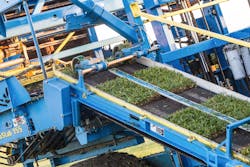Manufacturers and machine builders understand the importance of R&D and how innovation can leapfrog you over the competition. For machine OEMs, continuing advances in the area of mechatronics have produced smarter machine designs faster.
FireFly Equipment recently introduced a new turf harvesting machine called the ProSlab 155—combining mechanical, electrical and software components in a self-propelled tractor. The new tractor design strays from the traditional, manual approach of stacking pallets of turf aboard a tractor.
The machine cuts slabs of grass and conveys those units to the back of the machine to the pallets, then holds the finished product. Standard machines hold about 168 units per pallet, though some turf-harvesting farms can stack as many as 300 grass slabs on a pallet.
For years, manual stacking to pallets has been the norm because the multiple motion profile requirements and closed system architectures haven’t been robust enough for the parallel operations. Most traditional turf-harvesting machines offer electrically operated valves that control the fluid power to hydraulic cylinders and motors for motion control.
FireFly called on National Instruments (NI) to provide an end-to-end solution to meet this machine design challenge with NI’s LabView design platform, CompactRIO control and field-programmable gate array (FPGA) technology for the multiple parallel operations.
The integrated control platform manages cutting and stacking operations and more than 30 parallel control loops that run in the processor and the FPGA. The FPGA component oversees signal processing and supervisory control for the machine. “Basically, this machine is an entire factory on wheels,” says Nicholas Butler, senior group manager, embedded systems, at NI.
The rolling factory gathers a plethora of sensing data for five axes of motion control. Encoders, proximity, pressure, image and optical level sensors translate into more than 150 channels of analog and digital I/O.
The FireFly team decided on servo electric motors to implement the high-speed motion control needed for stacking turf slabs, instead of fluid power. The grass slabs traverse the conveyor and image sensors register the exact location for the handoff to the pallet stacker. The pallet stacker activates and picks the slabs, and carries them to predetermined locations on the pallet. A pallet can be filled in two minutes with the new turf machine.
Designers sought a servo system for the multi-axis motion with repeatability in mind, but also the high-volume cycle requirements of a million units a year. To address this requirement, the machine uses LabView’s SoftMotion module and Kollmorgen AKD servo drives and motors, which are connected directly to the CompactRIO processor.
“The control platform is really well-suited to integrate both hydraulic valves and servo motor functionality,” says Steve Aposhian, president and chief engineer at FireFly Automatix. “All of the pallet stacker movement is controlled by the servo motor except for the hooks that grab the turf slabs at the top of the conveyor. These are controlled by hydraulic valves.” These same control loops manage both systems and provide tight synchronization between these functions.
Fluid power is used for less-demanding and higher-energy density requirements on the machine, such as the turf cutter, forklift, pallet magazine and propulsion.
Parallel operations
With such platform flexibility, the mechanical designers of the machine were able to use a variety of sensor types and signals to create a highly optimized system. The turf cutter system recognizes the more than 76 sensors using multiple CAN buses, EtherNet TCP/IP and EtherCAT networks.
The simplicity of the machine design is achieved through a dual-core processor and integrated FPGA that oversees a drive-by-wire propulsion system, five axes of servo motion control, and 30 electrically operated fluid power valves. That’s a lot of power for a machine designer. However, the ability to pass data between control loops and processor and FPGA also provides a great design tool for the parallel operations.
With so much data being produced, the critical software loops are constantly monitored. The electric and power distribution systems include redundant controls for disabling the motion control system—both the servo and fluid power. Redundant sensors are also in place for critical signals, such as steering and propulsion. The machine can be instantly switched to redundant operation modes when a fault is detected, such as a sensor failure.
Firmware updates can be pushed out to a turf-harvesting machine to optimize machine production, along with the ability for remote monitoring. End users can oversee slabs and pallet counts, and raw sensor data such as temperature, pressure and bus voltage on operating machines. Besides the condition monitoring, much of the maintenance is based on cycle count, according to FireFly.
This machine design provides valuable data to customers, but productivity numbers are working well, too. With the new design, this factory on wheels increases harvesting speed by 20 percent and cuts diesel fuel consumption in half.
About the Author
Grant Gerke
Digital Managing Editor

Leaders relevant to this article:
